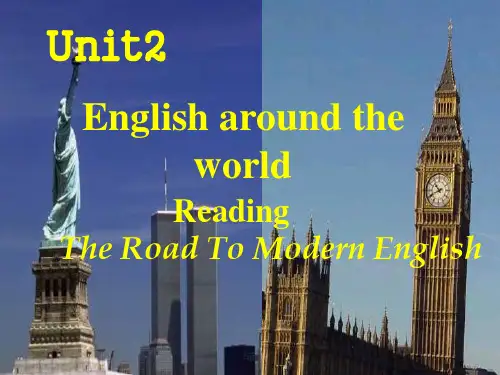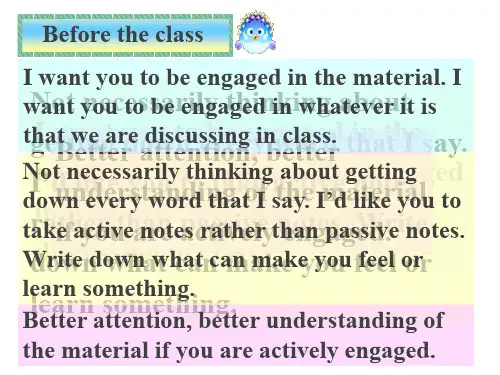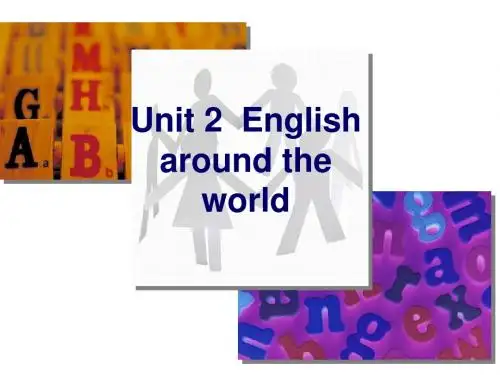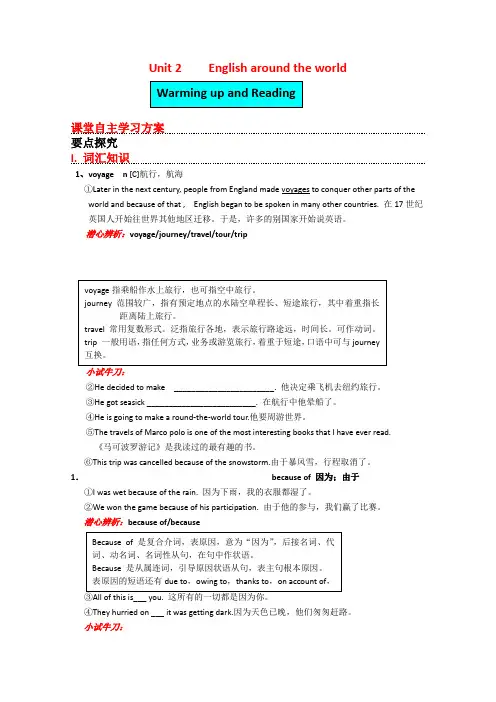新人教版必修一 Unit 2 English around the world-Warming up and Reading[优秀教案]
- 格式:doc
- 大小:80.50 KB
- 文档页数:8

![新人教版必修一_Unit_2_English_around_the_world全单元[教案]](https://uimg.taocdn.com/2eacb2527fd5360cba1adb35.webp)
Teaching planTeaching aims:1. Get the students to learn different reading skills.2. Get the students to learn about the English language.Teaching important points:1. Develop the students reading ability and let them learn to use some reading strategies such as skimming, scanning, and so on.2.Enable the students to learn about English language and know different kinds of English so as to communicate with people from different countries.Teaching difficult points:Develop the students’ readi ng ability.Teaching methods :Task-based teaching and learningUnit 2English around the world知识目标:本单元需要学习的重点单词为:include role international native elevator flat apartment rubber petrol gas modern culture AD actually present(adj. )rule(v. ) vocabulary usage identity government Singapore Malaysia rapidly phrase candy lorry command request retell polite boss standard Midwestern southern Spanish eastern southeastern northwestern recognize accent lightning direction ma’am subway block本单元需要学习的重点词组为:play a role in because of come up such as play a part(in) 本单元需要学习的重点句型为:1. World English comes from those countries, where English plays an important role as a first or second language, either because of foreign rule or because of its special role as an international language. (the Attributive Clause; either. . . or. . . )2. Native English speakers can understand each other even if they don’t speak the same kind of English. (even if. . . )3. It became less like German, and more like French because those who ruled England at that time spoke French. (those who. . . )4. Today the number of people learning English in China is increasing rapidly. (the number of+ n. 作主语时,谓语动词用单数形式)5. Believe it or not, there is no such a thing as standard English. (Believe it or not, . . . )6. The US is a large country in which many different dialects are spoken. (the Attributive Clause)7. In fact, an English dictionary like the kind you use today wasn’t made until the time of the Qing Dynasty. (the Attributive Clause; not. . . until. . . )8. These men spent nearly all of their lives trying to collect words for their dictionaries. (spend. . . in doing sth. )9. At the age of fourteen, he left his village school in Scotland and taught himself while working ina bank. (while doing. . . )10. We know that languages develop and change over time and that is why we have new dictionaries from time to time. (that is why. . . )本单元需要掌握的交际功能用语为:语言交际困难(Difficulties in language communication) Pardon?I beg your pardon?I don’t understand.Could you say that again please?Sorry, I can’t follow you.Could you repeat that, please?Could you speak more slowly, please?How do you spell it, please?本单元需要掌握的语法为:祈使句及其间接引语(the imperative sentence and its indirect speech)1. 要求或命令(demands or orders)“Open the door, ” told he.→He told/ordered me to open the door.2. 请求(requests)He said, “Please open the door. /Would you please open the door? ”→He asked me to open the door.能力目标:1. 能运用所学语言知识谈论有关“世界英语”方面的话题。
![新人教版必修一 Unit 2 English around the world全单元[教案]](https://uimg.taocdn.com/fef82b3d580216fc700afd84.webp)
Teaching planTeaching aims:1. Get the students to learn different reading skills.2. Get the students to learn about the English language.Teaching important points:1. Develop the students reading ability and let them learn to use some reading strategies such as skimming, scanning, and so on.2.Enable the students to learn about English language and know different kinds of English so as to communicate with people from different countries.Teaching difficult points:Develop the students’ readi ng ability.Teaching methods :Task-based teaching and learningUnit 2English around the world知识目标:本单元需要学习的重点单词为:include role international native elevator flat apartment rubber petrol gas modern culture AD actually present(adj. )rule(v. ) vocabulary usage identity government Singapore Malaysia rapidly phrase candy lorry command request retell polite boss standard Midwestern southern Spanish eastern southeastern northwestern recognize accent lightning direction ma’am subway block本单元需要学习的重点词组为:play a role in because of come up such as play a part(in) 本单元需要学习的重点句型为:1. World English comes from those countries, where English plays an important role as a first or second language, either because of foreign rule or because of its special role as an international language. (the Attributive Clause; either. . . or. . . )2. Native English speakers can understand each other even if they don’t speak the same kind of English. (even if. . . )3. It became less like German, and more like French because those who ruled England at that time spoke French. (those who. . . )4. Today the number of people learning English in China is increasing rapidly. (the number of+ n. 作主语时,谓语动词用单数形式)5. Believe it or not, there is no such a thing as standard English. (Believe it or not, . . . )6. The US is a large country in which many different dialects are spoken. (the Attributive Clause)7. In fact, an English dictionary like the kind you use today wasn’t made until the time of the Qing Dynasty. (the Attributive Clause; not. . . until. . . )8. These men spent nearly all of their lives trying to collect words for their dictionaries. (spend. . . in doing sth. )9. At the age of fourteen, he left his village school in Scotland and taught himself while working ina bank. (while doing. . . )10. We know that languages develop and change over time and that is why we have new dictionaries from time to time. (that is why. . . )本单元需要掌握的交际功能用语为:语言交际困难(Difficulties in language communication) Pardon?I beg your pardon?I don’t understand.Could you say that again please?Sorry, I can’t follow you.Could you repeat that, please?Could you speak more slowly, please?How do you spell it, please?本单元需要掌握的语法为:祈使句及其间接引语(the imperative sentence and its indirect speech)1. 要求或命令(demands or orders)“Open the door, ” told he.→He told/ordered me to open the door.2. 请求(requests)He said, “Please open the door. /Would you please open the door? ”→He asked me to open the door.能力目标:1. 能运用所学语言知识谈论有关“世界英语”方面的话题。

人教高中英语必修一unit2教案Module 1 Unit 2 English around the world●单元规划本单元主要围绕English around the world这一主题介绍了英语的使用情况、发展情况及各地不同的方言。
第二单元English around the world的设计可分为五部分。
第一部分learn something about words and expressions;第二部分warming up and reading;第三部分the structure which expresses commands and requests;第四部分using language;第五部分writing and speaking;●课时安排本单元教学可分为6个课时。
第一课时vocabulary;第二课时为reading;第三课时为language points;第四课时为grammar;第五课时为using language;第六课时为writing and speaking;第七课时为revisionThe First Period Words and expressionsTeaching aims :1. Know the key words and expressions in the whole unit:elevator, petrol, official, voyage, actually, base, identity, command, request, recognize, straight, because of, come up, at present, such as, play a part (in)……2. Enable the students to get familiar with the pronunciation of the important words.3. Prepare for the learning process of the whole unit.Teaching important points :1.Get familiar with the words in the text part.2.Master the important expressions such as:bec ause of, come up, at present, such as, play a part (in)……Teaching methods: Task-based teaching and learning; cooperative-learning; group discussionTeaching procedures :Step 1、Self-directed learning学习方法指导:第一步:写出所给单词的音标;第二步:大声朗读三遍,注意画线字母的发音;第三步:依次写出画线字母的音标。



Unit 2 English around the world课堂自主学习方案 要点探究 I. 词汇知识1、voyage n [C]航行,航海①Later in the next century, people from England made voyages to conquer other parts of the world and because of that , English began to be spoken in many other countries. 在17世纪英国人开始往世界其他地区迁移。
于是,许多的别国家开始说英语。
潜心辨析:voyage/journey/travel/tour/trip②He decided to make _______________________. 他决定乘飞机去纽约旅行。
③He got seasick _________________________. 在航行中他晕船了。
④He is going to make a round-the-world tour.他要周游世界。
⑤The travels of Marco polo is one of the most interesting books that I have ever read. 《马可波罗游记》是我读过的最有趣的书。
⑥This trip was cancelled because of the snowstorm.由于暴风雪,行程取消了。
1. because of 因为;由于①I was wet because of the rain. 因为下雨,我的衣服都湿了。
②We won the game because of his participation. 由于他的参与,我们赢了比赛。
潜心辨析:because of/because④They hurried on ___ it was getting dark.因为天色已晚,他们匆匆赶路。
第 1 页 共 8 页 Unit 2 English around the world 单元规则 本单元的中心话题是“世界英语(English around the world)”,主要介绍了英语及其在世界上的发展状况(English language and its development)和各种各样带有民族、地域特色的英语(different kinds of English)等具体内容。语言知识和语言技能等都是围绕“世界英语”(English around the world)这一中心话题展开的。通过对这一话题的探讨,旨在加强学生对英语语言的了解,对当代语言特别是英语发展趋势的了解。 为了围绕中心话题开展听、说、读、写活动,本单元安排了八个部分:“热身(Warming Up)”“读前(Pre-reading)”“阅读(Reading)”“理解(Comprehending)”“语言学习(Learning about Language)”“语言运用(Using Language)”“小结(Summing Up)”和“学习建议(Learning Tip)”。 “热身(Warming Up)”部分以问答(Do you know that there is more than one kind of English in the world? )和图表的形式,简要介绍了世界英语以及英语语言在某些重要方面有很大差异,使学生感受到英语语言的多文化、多层次、多元性,对英国英语和美国英语的不同有一个粗浅的了解,为本单元的进一步学习作好了准备。 “读前(Pre-reading)”部分设计了三个步骤都与单元主题有关,因此可以引发学生对课文主题的思考,以便参与课堂活动。这时可以展开简短的讨论,讨论时要鼓励学生独立思考,阐述不同的看法。 “阅读(Reading)”部分提供了一篇文章,标题是THE ROAD TO MODERN ENGLISH,简要地说明了英语语言的起源、发展变化、形成原因,以及它的发展趋势。通过这篇文章,使学生了解一些关于英语的知识,了解一点当代语言新趋势和新特点,明确为什么除了英国英语和美国英语还会有印度英语、加拿大英语等,以后可能还会有中国英语。 “理解(Comprehending)”部分设计了三个练习,练习1判断正误,旨在检测学生对课文基本内容的理解程度;练习2列出英语的发展阶段,旨在检测学生的归纳概括能力;练习3回答问题, 要求学生结合实际作答,目的是挖掘学生的学习潜能。这阶段要注意给他们提供充分的思维时间和空间,让他们做学习的主人,学会自己解决问题。 “语言学习(Learning about Language)”部分教学本课重点词汇和重点语法项目。词汇部分设计了4个练习:练习1是给新单词和短语与其释义配对;练习2是用练习1中的一些单词完成段落;练习3是将短语填入段落中使其具有意义,并将这些意群标出;练习4告诉我们有时英国人和美国人使用不同的介词,要求用英国英语和美国英语的介词填空,并比较它们的不同。设计这些练习的主要目的是通过各种练习帮助学生重温本单元前几个部分所学习的新单词和短语,同时也通过新的例子展现了美国英语、英国英语的差异。在这一环节中,教师要引导学生自学、自做、自助、自悟,并适时适当地给以指导点拨,使学生形成自主学习意识,掌握合适的学习策略。语法项目是祈使句及其间接引语,设计了四个步骤:步骤1问能否从“阅读(Reading)”部分中找到表示“要求”和“请求”的祈使句,观察如何用间接引语来复述;步骤2首先着重介绍了表示“要求”和表示“请求”的祈使句之间的不同,然后要求将所给表达按“要求”和“请求”分类;步骤3要求先判断所给句子是“要求”还是“请求”,然后用间接引语复述;步骤4要求运用“要求”和“请求”结合具体语境编对话。设计这些练习的目的就是让学生了解表示“要求”和表示“请求”的祈使句之间的不同,理解并运用它们以及学会正确地转述“要求”和“请求”。教师在教学中要注意启发学生从实际语境出发,理解说话人的语气,灵活掌握。 “语言运用(Using Language)”部分分为Reading, Listening, Reading and speaking和Writing四个步骤:Reading主要介绍了在当今世界各国各地说英语都有自己的特色,即便是美国东西部、南北部,说话也有所不同。学生读完文章后可讨论中国的方言,使他们感受到 第 2 页 共 8 页
本国语言文化差异,这有助于培养跨文化意识;Listening部分取材于一个美国男孩的独白录音,他来自美国南部得克萨斯州的休斯敦市,因此带有浓重的南方口音。旨在让学生感受一下将英语作为母语的本国人说话的一个侧面,所以教师在指导学生进行听力训练时,要注意掌握尺度,让学生感觉一下、了解一下,点到为止,不提倡硬性模仿;Reading and speaking主要让学生通过练习对话再次感悟和体验英国英语和美国英语的差异,随后还要求学生选择所提供的情景编对话,以灵活生动的对话形式帮助学生熟练掌握并运用直接引语和间接引语表达请求或要求;Writing部分让学生根据所给示范步骤,完成“Why should we learn English? ”的主题写作任务。在这一环节中,教师应想方设法激发学生的学习热情,让学生学会自己动手收集信息、处理信息,用所学语言去实践,通过自学、自做解决问题。这样做既锻炼了学生听、说、读、写的语言运用能力,又培养了学生发现问题,解决问题的能力。 “小结(Summing Up)”部分设计了一个表格,引导学生从本单元的话题、词汇和语法等方面对所学内容进行归纳总结。这样做的不仅便于学生复习掌握本单元的要点,而且有助于学生养成良好的学习习惯,从而提高学习效率,同时也锻炼了学生的归纳和总结的能力。 “学习建议(Learning Tip)”部分,向学生揭示英语词汇学习的一个重要特点,即一词多义,同时提醒学生注意这一特点,并鼓励他们运用多义词编绕口令、笑话等,增加了学生学习英语的兴趣。 知识目标: 本单元需要学习的重点单词为:include role international native elevator flat apartment rubber petrol gas modern culture AD actually present(adj. ) rule(v. ) vocabulary usage identity government Singapore Malaysia rapidly phrase candy lorry command request retell polite boss standard Midwestern southern Spanish eastern southeastern northwestern recognize accent lightning direction ma’am subway block 本单元需要学习的重点词组为:play a role in because of come up such as play a part(in) 本单元需要学习的重点句型为: 1. World Englishes come from those countries, where English plays an important role as a first or second language, either because of foreign rule or because of its special role as an international language. (the Attributive Clause; either. . . or. . . ) 2. Native English speakers can understand each other even if they don’t speak the same kind of English. (even if. . . ) 3. It became less like German, and more like French because those who ruled England at that time spoke French. (those who. . . ) 4. Today the number of people learning English in China is increasing rapidly. (the number of+ n. 作主语时,谓语动词用单数形式) 5. Believe it or not, there is no such a thing as standard English. (Believe it or not, . . . ) 6. The US is a large country in which many different dialects are spoken. (the Attributive Clause) 7. In fact, an English dictionary like the kind you use today wasn’t made until the time of the Qing Dynasty. (the Attributive Clause; not. . . until. . . ) 8. These men spent nearly all of their lives trying to collect words for their dictionaries. (spend. . . in doing sth. ) 9. At the age of fourteen, he left his village school in Scotland and taught himself while working in a bank. (while doing. . . )